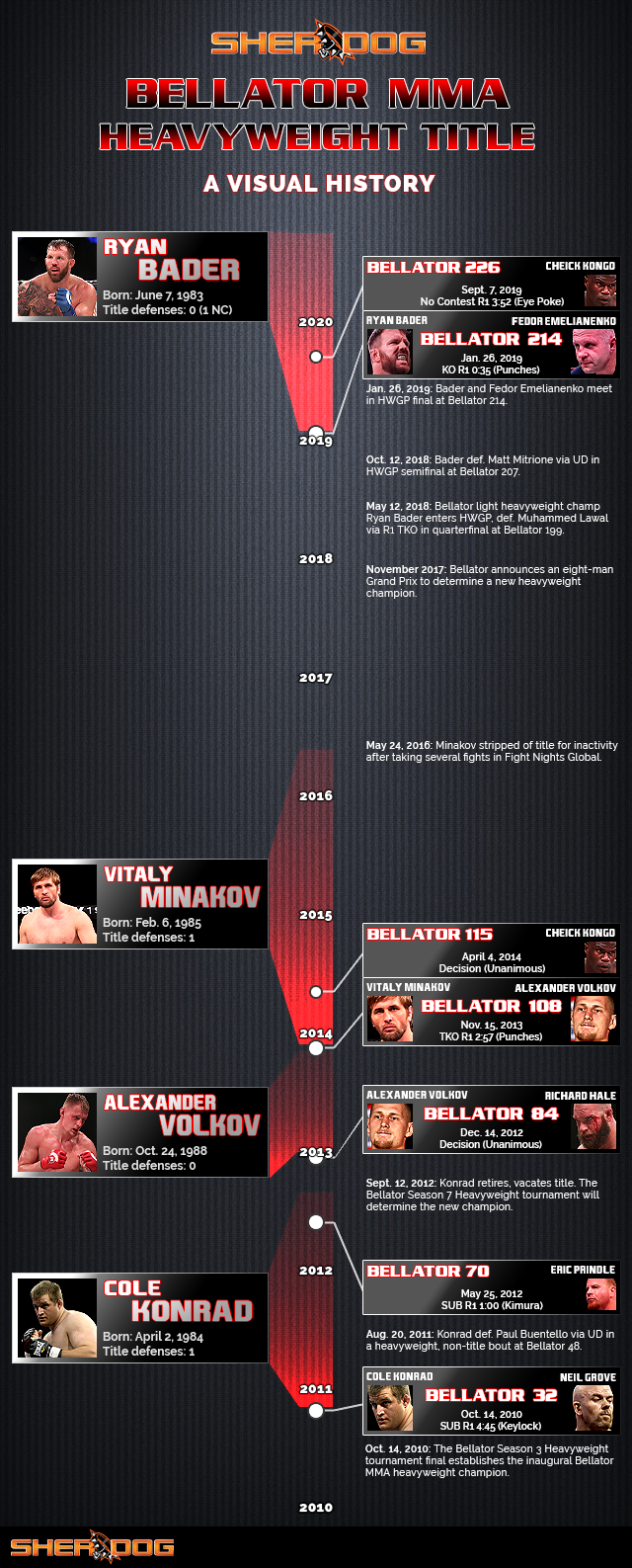Ryan
Bader may have lost his Bellator MMA light heavyweight belt in decisive
fashion on Friday night, but he still has the heavyweight belt to
defend. Looking at the history of that unloved, neglected strap,
one can only say: it’s about time.
While the graphic speaks eloquently of what a mess the Bellator heavyweight title has been since its inception almost a decade ago, to be fair, heavyweight has always been the most problematic division in MMA. Due to the sheer physics that make heavyweight so volatile—the usual shorthand is “everyone there has knockout power”—it is exceedingly difficult for a fighter to sustain a title reign. Consider the fact that until Stipe Miocic came along, nobody in the 20-year history of the Ultimate Fighting Championship heavyweight division had managed to defend the title three times in a row. At the same time, the scarcity of skilled, athletic men of heavyweight size makes it similarly difficult for a promotion to provide a stream of credible challengers every few months: Fedor Emelianenko, in his prime as the best heavyweight in the world, fighting in the best heavyweight division in the sport, only defended his Pride Fighting Championships title three times in five years.
Bellator seemed well aware of the big-man conundrum, as it did not
even introduce a heavyweight title until Season 4. The champ who
emerged from the Season 4 tourney, Cole Konrad,
was a young, undefeated prospect with two NCAA Division I wrestling
titles on his mantel, and appeared to be the future of the
division—that is, until he abruptly retired at age 27 and never
looked back. That set the tone for the subsequent history of the
Bellator heavyweight division. The four men who have held the belt
have all been excellent fighters, among the best heavyweights in
the sport, but a division has not truly coalesced around them.
Konrad’s retirement likely stemmed from his frustration with his
sporadic and frankly unchallenging fight schedule, while Minakov
simply shrugged and kept taking fights in his native Russia as
Bellator stripped him of the belt. Much like the early years of its
UFC counterpart, Bellator's heavyweight division suffered champions
walking away for other promotions, and like the UFC middleweight
and lightweight divisions, endured several years during which there
was no champion at all.
Bader put an end to that nearly three-year interregnum with his breathtakingly dominant run through the heavyweight Grand Prix, as he wiped out Muhammed Lawal, Matt Mitrione and Emelianenko without having a single strike landed on him. That was good enough to make him Bellator’s first simultaneous two-division champion, but it had required him to leave his light heavyweight belt in mothballs for over two years as the heavyweight tournament played itself out, and left the question of whether—and how—he planned to defend both titles. Now that Vadim Nemkov has relieved him of that problem, perhaps Bader will elect to fight out the final chapter of his career in the heavyweight division, where his 38 years make him a veritable spring chicken. The division could certainly use the stability, and it is practically a blank slate that he could make his own, while elevating his personal legacy in the sport.
Here is the nearly 10-year history of the Bellator heavyweight title and the times it was won, lost or defended. It tells the story of a series of worthy titleholders in a promotion that has thus far struggled to hold their interest.

While the graphic speaks eloquently of what a mess the Bellator heavyweight title has been since its inception almost a decade ago, to be fair, heavyweight has always been the most problematic division in MMA. Due to the sheer physics that make heavyweight so volatile—the usual shorthand is “everyone there has knockout power”—it is exceedingly difficult for a fighter to sustain a title reign. Consider the fact that until Stipe Miocic came along, nobody in the 20-year history of the Ultimate Fighting Championship heavyweight division had managed to defend the title three times in a row. At the same time, the scarcity of skilled, athletic men of heavyweight size makes it similarly difficult for a promotion to provide a stream of credible challengers every few months: Fedor Emelianenko, in his prime as the best heavyweight in the world, fighting in the best heavyweight division in the sport, only defended his Pride Fighting Championships title three times in five years.
Advertisement
Bader put an end to that nearly three-year interregnum with his breathtakingly dominant run through the heavyweight Grand Prix, as he wiped out Muhammed Lawal, Matt Mitrione and Emelianenko without having a single strike landed on him. That was good enough to make him Bellator’s first simultaneous two-division champion, but it had required him to leave his light heavyweight belt in mothballs for over two years as the heavyweight tournament played itself out, and left the question of whether—and how—he planned to defend both titles. Now that Vadim Nemkov has relieved him of that problem, perhaps Bader will elect to fight out the final chapter of his career in the heavyweight division, where his 38 years make him a veritable spring chicken. The division could certainly use the stability, and it is practically a blank slate that he could make his own, while elevating his personal legacy in the sport.
Here is the nearly 10-year history of the Bellator heavyweight title and the times it was won, lost or defended. It tells the story of a series of worthy titleholders in a promotion that has thus far struggled to hold their interest.

Ben
Duffy/Sherdog.com illustration
Related Articles







